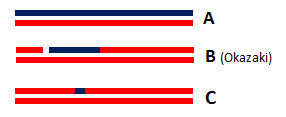Sandbox Reserved 967
From Proteopedia
(Difference between revisions)
| Line 31: | Line 31: | ||
=== Several interactions between the subunits === | === Several interactions between the subunits === | ||
H2C protein is found in the middle of the elongated complex structure, flanked by H2A and H2B proteins on the ends. | H2C protein is found in the middle of the elongated complex structure, flanked by H2A and H2B proteins on the ends. | ||
| - | The complex is stabilized by the intimately interwoven architecture of H2B and H2C: The N-terminal region of H2B protein (amino acids 1-92) weaves together with H2C domain to form 3 β-barrels, called <scene name='60/604486/Triple_barrel/2'>“triple barrel”</scene><ref name ="ref9"> Nicholson, Allen W. Ribonucleases. Springer Science & Business Media, 2011.</ref>. This triple barrel is formed from a total of <scene name='60/604486/Triple_barrel/1'>18 β-sheets</scene> and produces a pseudo-2-fold axis of symmetry along the central barrel. Also, it permits to leave the mostly α-helical C-terminal region of H2B available for potential interactions with other protein (for example the PCNA protein). Finally, it has been found that the motif provides a platform for securely binding the H2A protein: the side and end of the first barrel in the subcomplex H2B/H2C form a <scene name='60/604486/Tight_interface_h2ah2c/2'>tight interface</scene> with amino acids 197-258 in the C-terminal region of H2A protein. This interface is mainly composed of hydrophobic residues | + | The complex is stabilized by the intimately interwoven architecture of H2B and H2C: The N-terminal region of H2B protein (amino acids 1-92) weaves together with H2C domain to form 3 β-barrels, called <scene name='60/604486/Triple_barrel/2'>“triple barrel”</scene><ref name ="ref9"> Nicholson, Allen W. Ribonucleases. Springer Science & Business Media, 2011.</ref>. This triple barrel is formed from a total of <scene name='60/604486/Triple_barrel/1'>18 β-sheets</scene> and produces a pseudo-2-fold axis of symmetry along the central barrel. Also, it permits to leave the mostly α-helical C-terminal region of H2B available for potential interactions with other protein (for example the PCNA protein). Finally, it has been found that the motif provides a platform for securely binding the H2A protein: the side and end of the first barrel in the subcomplex H2B/H2C form a <scene name='60/604486/Tight_interface_h2ah2c/2'>tight interface</scene> with amino acids 197-258 in the C-terminal region of H2A protein. This interface is mainly composed of hydrophobic residues |
Revision as of 22:19, 9 January 2015
| This Sandbox is Reserved from 15/11/2014, through 15/05/2015 for use in the course "Biomolecule" taught by Bruno Kieffer at the Strasbourg University. This reservation includes Sandbox Reserved 951 through Sandbox Reserved 975. |
To get started:
More help: Help:Editing |
Structure of the Mouse RNase H2 Complex
| |||||||||||
References
</references>
Proteopedia page contributors and editors
Anaïs Bourbigot & Valériane Keïta

